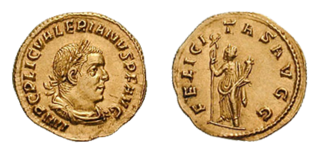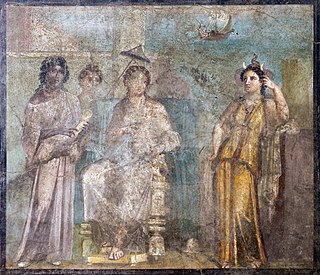
Tyche was the presiding tutelary deity who governed the fortune and prosperity of a city, its destiny. In Classical Greek mythology, she is usually the daughter of the Titans Tethys and Oceanus, or sometimes Zeus, and at this time served to bring positive messages to people, relating to external events outside their control.

In ancient Roman religion, Abundantia, also called Abundita or Copia, was a divine personification of abundance and prosperity. The name Abundantia means plenty or riches. This name is fitting as Abundantia was a goddess of abundance, money-flow, prosperity, fortune, valuables, and success. She would help protect your savings and investments. Abundantia would even assist someone with major purchases. She was among the embodiments of virtues in religious propaganda that cast the emperor as the ensurer of "Golden Age" conditions. Abundantia thus figures in art, cult, and literature, but has little mythology as such. She may have survived in some form in Roman Gaul and medieval France. Abundantia would carry a cornucopia that was filled with grain and coins. She would occasionally leave some of her grain or money at someone's house as a gift.

In ancient Roman culture, felicitas is a condition of divinely inspired productivity, blessedness, or happiness. Felicitas could encompass both a woman's fertility and a general's luck or good fortune. The divine personification of Felicitas was cultivated as a goddess. Although felicitas may be translated as "good luck," and the goddess Felicitas shares some characteristics and attributes with Fortuna, the two were distinguished in Roman religion. Fortuna was unpredictable and her effects could be negative, as the existence of an altar to Mala Fortuna acknowledges. Felicitas, however, always had a positive significance. She appears with several epithets that focus on aspects of her divine power.

In classical antiquity, the cornucopia, from Latin cornu (horn) and copia (abundance), also called the horn of plenty, was a symbol of abundance and nourishment, commonly a large horn-shaped container overflowing with produce, flowers, or nuts.

Nephthys or Nebet-Het in ancient Egyptian was a goddess in ancient Egyptian religion. A member of the Great Ennead of Heliopolis in Egyptian mythology, she was a daughter of Nut and Geb. Nephthys was typically paired with her sister Isis in funerary rites because of their role as protectors of the mummy and the god Osiris and as the sister-wife of Set.

Parvati, Uma or Gauri is the Hindu goddess of power, energy, nourishment, harmony, love, beauty, devotion, and motherhood. She is a physical representation of Mahadevi in her complete form. She is also revered in her appearances as Durga and Kali. She is one of the central deities of the goddess-oriented sect called Shaktism, and the chief goddess in Shaivism. Along with Lakshmi and Saraswati, she forms the Tridevi.

Lakshmi, also known as Shri, is one of the principal goddesses in Hinduism. She is the goddess of wealth, fortune, power, beauty, fertility and prosperity, and associated with Maya ("Illusion"). Along with Parvati and Saraswati, she forms the Tridevi of Hindu goddesses.

In ancient Roman religion, Roma was a female deity who personified the city of Rome and more broadly, the Roman state. She was created and promoted to represent and propagate certain of Rome's ideas about itself, and to justify its rule. She was portrayed on coins, sculptures, architectural designs, and at official games and festivals. Images of Roma had elements in common with other goddesses, such as Rome's Minerva, her Greek equivalent Athena and various manifestations of Greek Tyches, who protected Greek city-states; among these, Roma stands dominant, over piled weapons that represent her conquests, and promising protection to the obedient. Her "Amazonian" iconography shows her "manly virtue" (virtus) as fierce mother of a warrior race, augmenting rather than replacing local goddesses. On some coinage of the Roman Imperial era, she is shown as a serene advisor, partner and protector of ruling emperors. In Rome, the Emperor Hadrian built and dedicated a gigantic temple to her as Roma Aeterna, and to Venus Felix,, emphasising the sacred, universal and eternal nature of the empire.

The concept of liberty has frequently been represented by personifications, often loosely shown as a female classical goddess. Examples include Marianne, the national personification of the French Republic and its values of Liberté, Égalité, Fraternité, the female Liberty portrayed on United States coins for well over a century, and many others. These descend from images on ancient Roman coins of the Roman goddess Libertas and from various developments from the Renaissance onwards. The Dutch Maiden was among the first, re-introducing the cap of liberty on a liberty pole featured in many types of image, though not using the Phrygian cap style that became conventional. The 1886 Statue of Liberty by Frédéric Auguste Bartholdi is a well-known example in art, a gift from France to the United States.

In ancient Roman religion, Concordia is the goddess who embodies agreement in marriage and society. Her Greek equivalent is usually regarded as Harmonia, with musical harmony a metaphor for an ideal of social concord or entente in the political discourse of the Republican era. She was thus often associated with Pax ("Peace") in representing a stable society. As such, she is more closely related to the Greek concept of homonoia, which was also represented by a goddess.

Astarte is the Hellenized form of the Ancient Near Eastern goddess ʿAṯtart. ʿAṯtart was the Northwest Semitic equivalent of the East Semitic goddess Ishtar.

Pax, more commonly known in English as Peace, was the Roman goddess of peace derived and adopted from the ancient Greek equivalent Eirene. Pax was seen as the daughter of the Roman king god Jupiter and the goddess Justice. Worship of Peace was organized and made popular during the rule of the emperor Augustus who used her imagery to help stabilise the empire after the years of turmoil and civil war of the late republic. Augustus commissioned an altar of peace in her honour on the Campus Martius called Ara Pacis, and the emperor Vespasian built a temple for her on called the Templum Pacis. Pax had a festival held for her on January 30. In art she is commonly depicted holding out olive branches as a peace offering, as well as a caduceus, cornucopia, corn and a sceptre. Pax is also often associated with spring.

In ancient Roman religion, Annona is the divine personification of the grain supply to the city of Rome. She is closely connected to the goddess Ceres, with whom she is often depicted in art.

Vasudhārā whose name means "stream of gems" in Sanskrit, is the Buddhist goddess of wealth, prosperity, and abundance. Her popularity peaks in Nepal where she has a strong following among the Buddhist Newars of the Kathmandu Valley and is thus a central figure in Newar Buddhism. She is one of the most popular goddesses worshipped in many Buddhist countries and is a subject of Buddhist legends and art.
In Roman mythology, Tranquillitas was the personification of tranquility. Tranquillitas seems to be related to Annona and Securitas, implying reference to the peaceful security of the Roman Empire. In the Roman context, the characteristics of Tranquilitas reflected the values at the heart of the Via Romana and are thought to be those qualities which gave the Roman Republic the moral strength to conquer and civilize the world.
Letitia is a feminine given name, of Latin origin meaning "joy, gladness". The name Letitia has many variants, including but not limited to: Lætitia from lætus (Latin), Letja (Dutch), Letizia (Italian), Leticia (Spanish), Letisya (Turkish) and Letisha or Latisha (American). The name Letitia first appeared in the form Lettice in medieval England and is derived from the Roman goddess Lætitia of gaiety, symbolic of happiness, prosperity and abundance.

Lady Justice is an allegorical personification of the moral force in judicial systems. Her attributes are scales, a sword and sometimes a blindfold. She often appears as a pair with Prudentia.

Fortuna Redux was a form of the goddess Fortuna in the Roman Empire who oversaw a return, as from a long or perilous journey. Her attributes were Fortuna's typical cornucopia, with her specific function represented by a rudder or steering oar sometimes in conjunction with a globe.

Goddess Africa, also known as Dea Africa, was the personification of Africa by the Romans in the early centuries of the common era. She was one of the fertility and abundance deities to some. Her iconography typically included an elephant-mask head dress, a cornucopia, a military standard, and a lion.
A gubernaculum in classical references describes a ship's rudder or steering oar. The English word government is related to the word. The Old English word governail and the Scots word gouernaill are both derived from it.

















